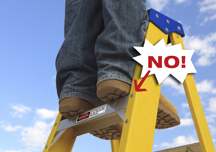
The holiday season is over, but hunting season is here...and then we’ll move to home repair season which could be year round, right? What’s that got to do with construction you ask? Nothing really except that in addition to using ladders at work, we use ladders to put up holiday decorations, access tree stands and other household uses. Inspection of ladders, as well as the proper use of them, is an important aspect of our work and while the goal is not to be injured at all, if you’re injured at home or at work you will still be in pain.
So, what do we look for when using ladders?
- Do an overall inspection.
- Check the steps for grease, mud or anything else that could make you slip.
- Check the side-rails for cracks, splinters and other damage.
- Look at the braces if it’s a step ladder.
- Check the size of the ladder. You need a ladder that is not only tall enough to get you where you need to be safely but you also need a ladder that will support the weight of the person climbing it and the material/tools they will have with them.
- Check the feet of the ladder. If it’s an extension ladder the non-skid feet need to be able to swivel to keep them flat on the surface. Step ladders usually don’t have the swiveling feet but the feet must be in good condition.
- Use the right ladder the right way!
- Never use an aluminum ladder when performing electrical work.
- Be aware of your clearance when using any ladder near electrical lines
- If you use an extension ladder, make sure it extends at least 3 feet from the landing area.
- Step ladders are designed to be used completely open with braces locked.
- Most extension ladders are not designed to be taken apart. That is usually because the extension part does not have proper feet to keep it from sliding.
- Only one person at a time on the ladder unless it is designed otherwise.
- Do not climb on the bracing
- Do not stand on the top 2 rungs. Usually there is a warning label at this level but it could have been removed.
- Do not over-reach. Rule of thumb is never allow your belly button to pass the side rail of the ladder.
- Climb using 3 points of contact at all times. 2 hands/1 foot, 2 feet/1 hand. You cannot do this if you have material or tools in your hands. Pull them up with a rope.
- Wear proper PPE
- Make sure your work boots are free of mud, oil, grease and that they have proper soles with some tread to keep you from slipping.
- If you’re working greater than 6’ from the next lower level, fall protection must be used.
- Safety glasses need to be worn to prevent any dust, water, insulation (did you see our previous article on eye safety??) or other types of foreign bodies from coming into contact with your eyes and causing you to fall.
- Hardhats are required if overhead hazards exist.
- Take care of your ladders
- When not in use, make sure they are properly stored out of rain, mud, sunlight, etc. … as much as possible.
- Do not paint your ladders for anything other than marking for identification.
